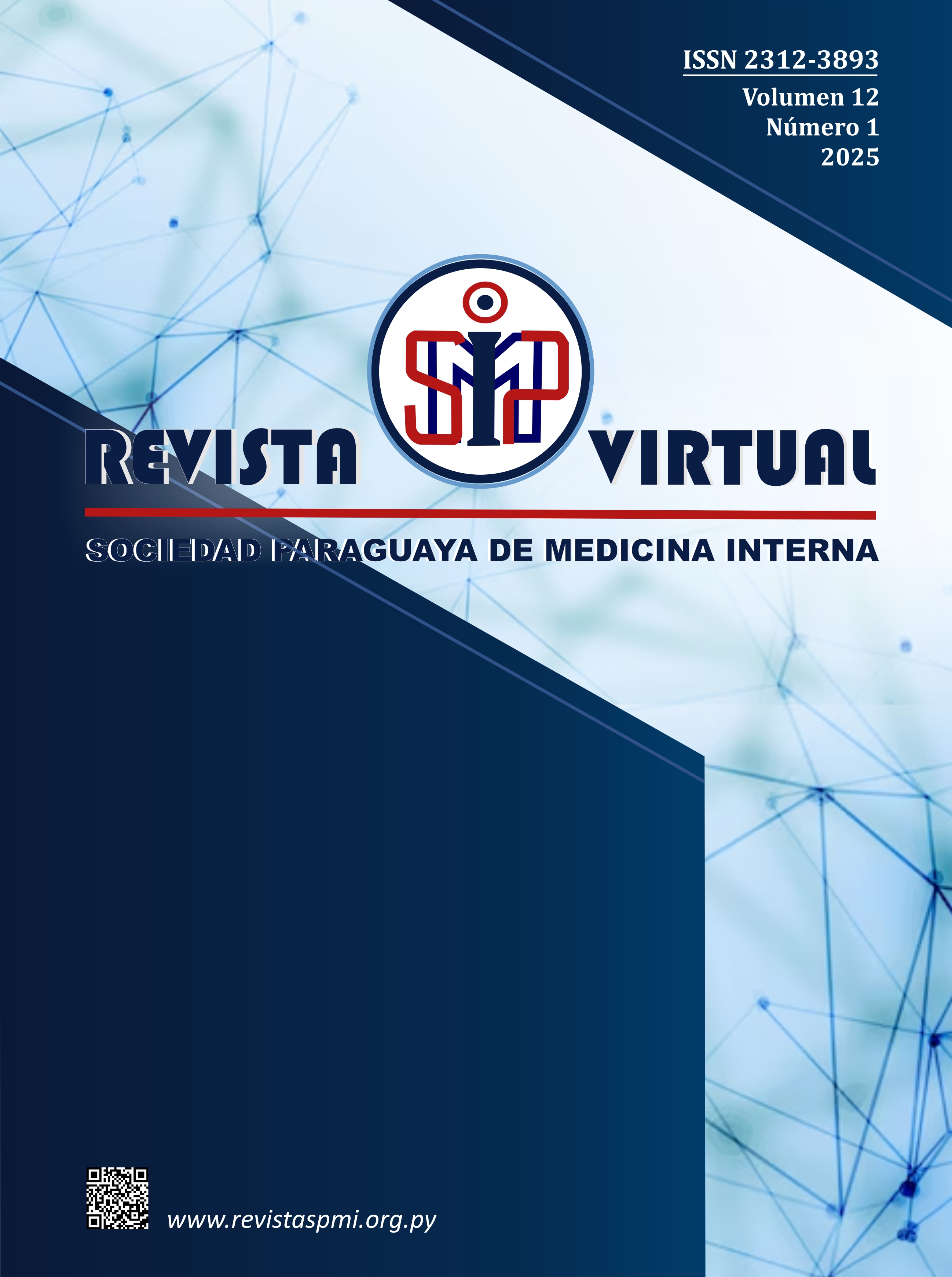Impacto de la ventilación mecánica en el manejo de la lesión cerebral traumática grave: revisión actualizada
Resumen
Introducción: la lesión cerebral traumática (LCT) es una causa principal de muerte y discapacidad, especialmente en jóvenes, con un alto impacto social debido a los costos de atención y la pérdida de productividad. La ventilación mecánica (VM) es esencial en el tratamiento de pacientes con LCT grave, pero su uso prolongado en unidades de cuidados intensivos (UCI) puede llevar a complicaciones como la neumonía asociada a la ventilación mecánica (NAVM). Este artículo revisa el impacto de la VM en la LCT grave, analizando estrategias de manejo, beneficios, riesgos y opciones de tratamiento para mejorar el pronóstico de estos pacientes críticos.
Metodología: se realizó una revisión sistemática mediante la búsqueda electrónica de estudios indexados en la página web de “PubMed”, “Scielo” y “Google Scholar".
Resultados: de los 42 artículos encontrados en la revisión, 30 fueron prescindidos por no cumplir con los criterios de inclusión o por cumplir con algún criterio de exclusión, quedando 13 artículos para esta revisión. Conclusiones: la VM es crucial en el manejo de la LTC grave al proporcionar soporte respiratorio esencial. Sin embargo, su uso prolongado aumenta el riesgo de complicaciones como la NAVM y otras infecciones pulmonares. Es necesario un enfoque individualizado y más estudios prospectivos para optimizar el manejo, prevenir complicaciones respiratorias y mejorar los resultados clínicos.
Citas
Bossers SM, Schwarte LA, Loer SA, Twisk JWR, Boer Ch, Schober P. Experience in prehospital endotracheal intubation significantly influences mortality of patients with severe traumatic brain injury: A systematic review and meta-analysis. PloS One [Internet]. 2015 [cited 2023 Oct 10];10(10):e0141034. Available from: https://pubmed.ncbi.nlm.nih.gov/26496440
Sierra Benítez EM, León Pérez MQ, Rodríguez Ramos E, Pérez Ortiz L. Caracterización clínico-quirúrgico, neuroimagenológico y por neuromonitorización del trauma craneoencefálico en la provincia matanzas. 2016-2018. Rev Med Electrón [Internet]. 2019 [citado 10 Oct 2023];41(2):368 -81. Disponible en: http://scielo.sld.cu/scielo.php?script=sci_abstract&pid =S1684-18242019000200368
Alberdi F, García I, Atutxa L, Zabarte M. Epidemiología del trauma grave. Med Intensiva [Internet]. 2014 [citado 10 Oct 2023];38(9):580-8. Disponible en: https://medintensiva.org/es-epidemiologia-del-trauma-grave-articulo-S0210569114001806
Koenig SM, Truwit JD. Ventilator-Associated Pneumonia: Diagnosis, treatment, and prevention. Clin Microbiol Rev [Internet]. 2006 [cited 2023 Oct 10] ;19(4):637-57. Available from: https://pubmed.ncbi.nlm.nih.gov/17041138
Chieregato A, Malacarne P, Cocciolo F, Ravaldini M, Russo E, Viaggi B, et al. Aggressive versus conservative antibiotic use to prevent and treat ventilator-associated pneumonia in patients with severe traumatic brain injury: comparison of two case series. Minerva Anestesiol [Internet]. 2017 [cited 2023 Oct 10];83(6):553-62. Available from: https://pubmed.ncbi.nlm.nih.gov/28275224
Villemure-Poliquin N, Costerousse O, Lessard Bonaventure P, Audet N, Lauzier F, Moore L, et al. Tracheostomy versus prolonged intubation in moderate to severe traumatic brain injury: a multicentre retrospective cohort study. Can J Anaesth [Internet]. 2023 [cited 2024 Enero 3];70(9):1516-26. Available from: https://pubmed.ncbi.nlm.nih.gov/37505417
Picetti E, Pelosi P, Taccone FS, Citerio G, Mancebo J, Robba Ch, et al. Ventilatory strategies in patients with severe traumatic brain injury: the VENTILO Survey of the European Society of Intensive Care Medicine (ESICM). Crit Care [Internet]. 2020 [cited 2023 Oct 10];24(1):158. Available from: https://pubmed.ncbi.nlm.nih.gov/32303255
Abujaber A, Fadlalla A, Gammoh D, Abdelrahman H, Mollazehi M, El-Menyar A. Prediction of in-hospital mortality in patients on mechanical ventilation post traumatic brain injury: machine learning approach. BMC Med Inform Decis Mak [Internet]. 2020 [cited 2023 Oct 10];20(1):336. Available from: https://pubmed.ncbi.nlm.nih.gov/33317528
Franco-Jiménez JA, Ceja-Espinosa A, Álvarez-Vázquez L, Vaca-Ruíz MA. Associated factors for Tracheostomy in adults with severe traumatic brain injury. Score proposal. Cir Cir [Internet]. 2020 [cited 2023 Oct 10];88(2):200-5. Available from: https://pubmed.ncbi.nlm.nih.gov/32116326
Giannakoulis VG, Psychogios G, Routsi Ch, Dimopoulou I, Siempos II. Effect of early versus delayed tracheostomy strategy on functional outcome of patients with severe traumatic brain injury: A target trial emulation. Crit Care Explor [Internet]. 2024 [cited 2023 Oct 10];6(8): e1145. Available from: https://pubmed.ncbi.nlm.nih.gov/39120085
Dong M, Zhou Y, Yang J, Yang J, Liao X, Kang Y. Compare the effect of noninvasive ventilation and tracheotomy in critically ill mechanically ventilated neurosurgical patients: a retrospective observe cohort study. BMC Neurol [Internet]. 2019 [cited 2023 Oct 10];19(1):79. Available from: https://pubmed.ncbi.nlm.nih.gov/31043155
Schwaiger P, Schöchl H, Oberladstätter D, Trimmel H, Voelckel WG. Postponing intubation in spontaneously breathing major trauma patients upon emergency room admission does not impair outcome. Scand J Trauma Resusc Emerg Med [Internet]. 2019 [cited 2023 Oct 10];27(1):80. Available from: https://pubmed.ncbi.nlm.nih.gov/31455331
Pakkanen T, Kämäräinen A, Huhtala H, Silfvast T, Nurmi J, Virkkunen I, Yli-Hankala A. Physician-staffed helicopter emergency medical service has a beneficial impact on the incidence of prehospital hypoxia and secured airways on patients with severe traumatic brain injury. Scand J Trauma Resusc Emerg Med [Internet]. 2017 [cited 2023 Oct 10];25(1):94. Available from: https://pubmed.ncbi.nlm.nih.gov/28915898
Öner Ö, Hanci V, Gürkok MÇ, Ergan B, Yaka E, Gökmen AN. The effect of amantadine treatment on neurological outcome and mortality in mechanically ventilated severe head trauma patients in intensive care unit. Medicine (Baltimore) [Internet]. 2024 [cited 2023 Oct 10];103(20): e38172. Available from: https://pubmed.ncbi.nlm.nih.gov/38758901
Asehnoune K, Seguin P, Lasocki S, Roquilly A, Delater A, Gros A, et al. Extubation success prediction in a multicentric cohort of patients with severe brain injury. Anesthesiology [Internet]. 2017 [cited 2023 Oct 10];127(2):338-46. Available from: https://pubmed.ncbi.nlm.nih.gov/28640020
González-Robledo J, Martín-González F, Moreno-García M, Sánchez-Barba M, Sánchez-Hernández F. Factores pronósticos relacionados con la mortalidad del paciente con trauma grave: desde la atención prehospitalaria hasta la Unidad de Cuidados Intensivos. Med Intensiva [Internet]. 2015 [citado 10 Oct 2023];39 (7):412-21. Disponible en: http://www.scielo.org.bo/scielo.php?script=sci_arttext&pid=S1726-89582015000200013
Cruz Morales R. Complicaciones asociadas a la ventilación mecánica invasiva. Npunto [Internet]. 2022 [citado 10 Oct 2023]; 5(49):27-45. Disponible en: https://www.npunto.es/revista/49/complicaciones-asociadas-a-la-ventilacion-mecanica-invasiva
Andriolo BN, Andriolo RB, Saconato H, Atallah ÁN, Valente O. Early versus late tracheostomy for critically ill patients. Cochrane Database Syst Rev [Internet]. 2015 [cited 2024 Dec 7];1(1): CD007271. Available from: https://pubmed.ncbi.nlm.nih.gov/25581416
Gómez Grande ML, Esquinas Rodríguez AM. Ventilación no invasiva en las Unidades de Cuidados Intensivos. Parte I: fundamentos e interfase. Enferm Intensiva [Internet]. 2007 [citado 10 Oct 2023];18(4):187-95. Disponible en: https://www.elsevier.es/es-revista-enfermeria-intensiva-142-articulo-ventilacion-no-invasiva-las-unidades-cuidados-intensivos-13113136
Santana-Cabrera L, Lorenzo-Torrent R, Sánchez-Palacios M, Martín Santana JD, Hernández Hernández JR. Pronóstico de los pacientes médicos según la duración de su estancia en la unidad de cuidados intensivos. Med Intensiva [Internet]. 2014 [citado 10 Oct 2023];38(2):126-7. Disponible en: https://www.medintensiva.org/es-pronostico-pacientes-medicos-segun-duracion-articulo-S0210569113001381

















